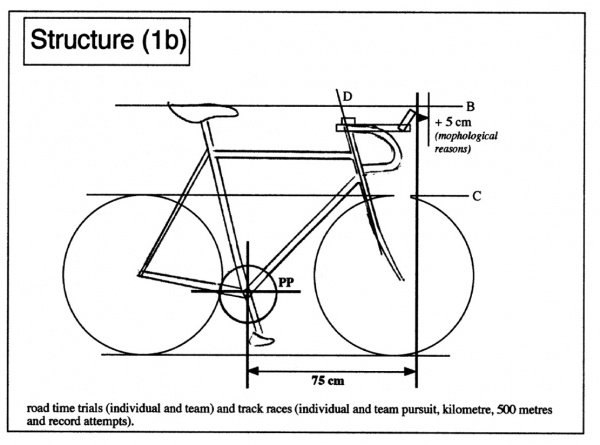The UCI vows to crack down on non-conforming technology
-
- Views: 12 842.
Recent word that the UCI was poised to impose an immediate change to its equipment regulations regarding aerodynamic tubing caused a small panic at this week’s Amgen Tour of California.
Rumor had it that cycling’s international governing body was ready to apply rules that would have kept a significant number of time trial bikes off the starting line in Friday’s stage 6 time trial at Solvang.
But in a news conference on Thursday, UCI president Pat McQuaid said that the issue involves mere “clarification” of existing rules and that none of the bikes that passed muster in last Saturday’s prologue would be barred from starting on Friday.
McQuaid added, however, that the discussion of the rules governing the construction of time trial bikes and components should serve as a warning shot to teams and manufacturers intent upon pushing the envelope in design.
Moment of panic
The fast-spreading rumors surrounding a possible rule change triggered an uproar akin to that last seen in the lead up to the 2007 Tour de France when the UCI again “clarified” its rules regarding aero extension positions, specifically making the ‘Praying Landis’ position illegal. At the time, many of the race’s best time trialists were forced to make last-minute position changes on the eve of that Tour.
The UCI’s latest reinterpretation of existing rules won’t have that sort of immediate impact on the 2009 AToC, but the UCI, said McQuaid, considers that it has given fair warning to those who “haven’t fully complied with existing rules.”
“In a short period of time we will insist that the rule is rigidly adhered to,” said McQuaid said.
The rule in question actually involves two sections of the UCI’s technical manual, regulating different aspects of aerodynamic shapes. In part, the rule limits an aerodynamic form’s aspect ratio to a maximum of three-to-one, meaning that a bicycle frame, or component on that frame, may not have a profile deeper than three times its width.
The rule isn’t new, but there had been some confusion regarding specific phrasing in a rulebook issued in both French and English. For example, some English speakers interpreted the word "fuselage" to apply only to the frame itself. McQuaid said the UCI made recent revisions in the English version of the rulebook simply to clarify the misinterpretations of rules originally drafted in French.
“First of all there’s no rule change,” said McQuaid. “It isn’t a new rule. This isn’t an alteration to a rule. The UCI hasn’t brought in any rule changes. This rule has been there for several years now. It’s rule 1.3.023 and 1.3.024.”
The issue according to McQuaid and the UCI’s Materials Group, which governs technical issues, is that manufacturers have repeatedly pushed up to, and in some cases exceeded, what he said are a clear set of rules. The latest uproar, he added, is simply a response to the UCI’s decision to rigidly enforce its existing rules.
“We’ve seen a certain number of the teams pushing the rule to its limit and some of them over the limit,” said McQuaid. “We have taken action at the level of the teams and manufacturers and expect them to organize themselves to come back in line.”
Over the past few months, the Materials Group, headed by technical consultant Jean Wauthier, analyzed a number of designs and found several to be out of compliance with existing rules.
In mid January the UCI sent a letter to the teams and the national federations explaining that the Materials Group was in the process of ramping up its enforcement after several years of less-than-rigid application of the rules.
McQuaid said that the UCI intends to enforce those rules, but won’t enforce immediate compliance so that teams and manufacturers have sufficient time to adhere.
McQuaid said that despite the uproar past design disputes caused at the time, most agree the UCI took the right path when it cracked down on the use of non-standard frames, such as those used by Graeme Obree and Chris Boardman when both men set world hour records on quite exotic equipment.
McQuaid said that while the rule will not be fully applied at the Tour of California, UCI officials will continue to gather information that will be used to further develop an enforcement plan in the future.
Reactions among teams and manufacturers were mixed on Thursday.
“There’s not really a clear line of communication from the UCI directly to the manufacturers, it usually comes through the teams and the teams have their own stuff to worry about,” said Rory Mason, Cannondale’s teams’ liaison. “We want to make sure we have the time to react and that we have a clear set of rules that are the same in every language, because we’ve found some discrepancies there.”
Alex Banyay, Team Type 1’s mechanic said he feels for the manufacturers.
“Maybe it hinders me a little bit but it hinders the bike companies a lot more,” he said. “They (the manufacturers) put millions of dollars into developing these bikes and the frames aren’t even close to legal with what they’re throwing at us now. It’s not really put on us as mechanics, it's more on the manufacturer they’re the ones who will be writing letters to Switzerland.”
McQuaid left unanswered the biggest question, namely when the UCI would begin strict enforcement of its interpretation of 1.3.023 and 1.3.024. Teams are hoping the announcement doesn’t come, say, the night before the start of this year’s Tour de France.
-
Related Posts
-
-- enable recent posts plugin --
-
Leave a Reply

